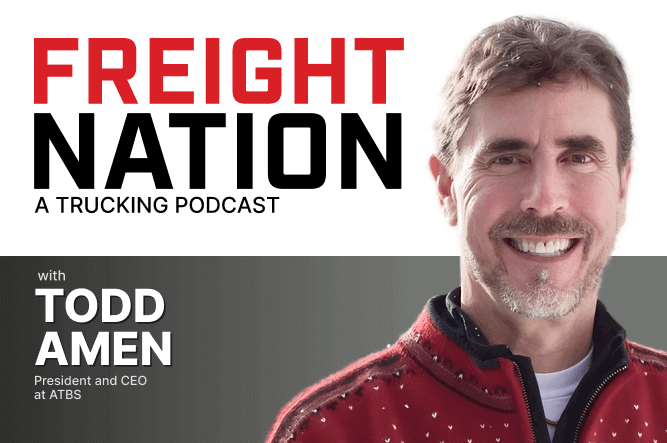How ATBS Revolutionized Trucking with Driver Data

Listen up!
Check out our trucking podcast, Freight Nation.
In this episode of Freight Nation: A Trucking Podcast, host Brent Hutto is joined by Todd Amen, President and CEO of the American Truck Business Services (ATBS). Together, they explore the opportunities and benefits of the owner-operator system, the history of ATBS, including their initial challenges, and the ever-evolving importance of driver data in the trucking industry.
The family history of ATBS
In the early 1960s, Todd’s father left farming to buy a truck line with three trucks. Todd and his brothers began working in the business young, each starting at age twelve. They did every job imaginable, from greasing trucks to office administration.
“I learned the business from the ground up, literally, and fell in love with it”.
It was this early exposure to trucking and hard work that spurred Todd and his three brothers to take over the business after their father retired. Their hands-on experience enabled their continued success until they sold the truck line in 1998. They then worked together to form ATBS, which helps drivers better understand and run their businesses by leveraging data.
Changing focus
In the mid-90s, while running their trucking business, driver turnover was their biggest frustration, a problem that still persists today. Drivers faced long hours and poor pay as fleet drivers, causing them to have no real incentive to improve efficiency.
After attempting to determine the profitability of trucks—which was near-impossible at that time with the technology available—Todd and ATBS decided to create an owner-operator fleet, which was a radical move at the time, but they believed a win-win scenario was possible.
“And we literally decided to convert our hundreds of drivers from company drivers to owner-operators. And we did it in eight months. We met with them each individually and personally, and went through it and signed agreements. And it turned out to be a great thing, really exactly what we expected it would. Drivers made more money, company made more money.”
Drivers who managed their business effectively could increase their pay by 40%, and the company also saw significant financial gains. The key was that drivers now had an integral part in improving their efficiency, which meant they cared more about fuel economy and tire wear.
Educating owner-operators
Trucking used to be straightforward; as Todd says, it was an easy business. Back in the 1990s, drivers just needed to focus on driving a lot of miles as fast as possible. The issue with this is that drivers usually didn’t know how to calculate metrics like miles-per-gallon or cost-per-mile.
Todd realized that the way to convince drivers who were set in their ways was to educate them about the cost-saving benefits of certain measures. For instance, drivers could make more money by saving a dollar, rather than generating an extra dollar of revenue, since a dollar saved is 100% bottom line, while they still have to pay a cost when driving faster or further.
While uptake was slow, Todd cites the massive fuel spike created by Hurricane Katrina as one reason why “drivers got hungry for information on how to succeed in their business other than shut the door and drive as fast as you can.”
How new resources are revolutionizing trucking
Todd says readily available reliable data and information have allowed drivers to find niches, shift their businesses, and adjust when necessary.
Todd cites some examples:
“They find the things that matter to them, whether it’s a great fuel program with a discount or even a fuel optimization program that helps me buy the right amount of fuel at the right places. Everybody can go as deep as they want, right? They can operate at 40,000 ft and just slow down and idle, or they can actually use optimization on the revenue side. They can subscribe to truckstop.com and go really deep in specific market areas and understand markets.”
Todd also suggests that this ability to move fast is one of the issues with larger fleets, and a benefit of owner-operators. The types of fast, challenging market changes that a larger fleet might find more difficult to navigate—Todd compares this to “turning the Titanic” —owner-operators can respond to quickly.
Benchmarking and data analysis
ATBS works with over 20,000 drivers on a daily basis, doing their books and taxes. One way of improving drivers’ performance is the practice of benchmarking, which is to sort them into various categories and compare them to their peers.
ATBS has a simple system to accomplish this:
“Every single month, your profit and loss statement has a benchmark: a red dot and a green dot. Red’s bad, green is good. I don’t have to be an expert in looking at a profit and loss statement, I simply look for red dots and green dots, and where I’ve got green, I’m doing good, I’m above average, keep doing it, and when I’ve got red, something’s wrong.”
This type of data analysis is beneficial because it allows Todd and his team to start having conversations the moment red dots start appearing on a driver’s record. What’s more, the drivers who use these insights can stay ahead of the curve, whether that’s deciding to be more choosy about jobs based on fuel price (rather than taking every job available and generating a lower profit margin) or continuing what they’re doing correctly.
To learn more about the benefits of leveraging data to improve owner-operator efficiency and the history of ATBS tune into this episode of Freight Nation: A Trucking Podcast on Apple, Spotify, or your favorite podcast platform.
Get helpful content delivered to your inbox.
Sign up today.
Find high-quality loads fast, get higher rates on every haul, and access tools that make your job easier at every turn.






